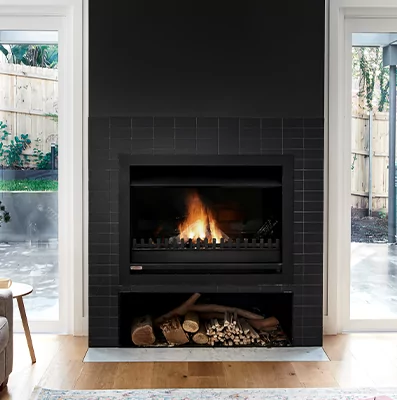
A certain charm and enchantment come with the crackling of a wood-burning fireplace on a cold winter night. It not only creates a cozy atmosphere but also provides much-needed warmth. Yet, a wood-burning fireplace from Master Fireplaces requires responsibility because it demands proper care to ensure safety, efficiency, and longevity. In this article, we’ll delve into essential tips for caring for your wood-burning fireplace so that you can fully enjoy its comforting heat and captivating beauty.
- Regular Cleaning
Your wood-burning fireplace should remain clean to keep functioning optimally. After each use, remove ashes and debris to prevent build-up, which can obstruct proper airflow and reduce efficiency. Wear protective gloves and use a metal scoop for safety. Additionally, schedule a thorough cleaning at least once a year by a professional chimney sweeper to remove soot and creosote and minimize the risk of chimney fires.
- Quality Firewood
The type and quality of firewood you choose impact the performance of your fireplace. Opt for well-seasoned hardwood like oak, maple, or hickory because it burns cleaner and produces less creosote buildup than softwood. Properly seasoned firewood dried for at least 6-12 months burns hotter and more efficiently. It reduces the formation of harmful deposits within your chimney.
- Adequate Airflow
Open the damper completely before starting a fire for adequate airflow in your wood-burning fireplace. It allows smoke and gases to go out through the chimney and prevents potential back drafts. Once the fire gets extinguished, close the damper to prevent cold air from entering and warm air from escaping.
- Use Fireplace Screens
Fireplace screens act as protective barriers between the flames and your home. It prevents sparks and embers from causing accidents. They also help keep curious hands and pets at a safe distance. Choose a screen for effective protection and complementing your decor.
- Inspect for Damage
Check your fireplace and chimney for signs of wear or damage. Look out for cracks, loose bricks, or damaged mortar because these issues can compromise structural integrity and pose safety risks. Address any problems promptly with the help of a professional to avoid potential hazards.
- Install a CO Detector
A carbon monoxide detector near your wood-burning fireplace is crucial due to emissions of this colorless and odorless gas. Carbon monoxide (CO) can be lethal to your health. Often check the batteries of the detector for the safety of your family.
Conclusion
A wood-burning fireplace from Master Fireplaces adds a delightful touch to your home. These indispensable care tips that every fireplace owner should adopt can keep your fireplace in pristine condition for its safe and efficient operation for years. So relish in the mesmerizing flames, and immerse yourself in the heart-warming embrace of your well-maintained wood-burning fireplace!

Pingback: difference between sildenafil tadalafil and vardenafil
Pingback: how much does zoloft cost
Pingback: leukorrhea metronidazole
Pingback: keflex and drinking
Pingback: can you drink on cephalexin 500mg
Pingback: abilify gabapentin
Pingback: withdrawal symptoms of lexapro
Pingback: cymbalta vs citalopram
Pingback: fluoxetine lexapro
Pingback: sildenafil capsules in india
Pingback: duloxetine side effects in detail
Pingback: how to make amoxicillin taste better
Pingback: side effects of escitalopram and alcohol
Pingback: ciprofloxacin take with food
Pingback: cephalexin how to take
Pingback: how long does bactrim take to work
Pingback: how long do you have to wait to drink alcohol after taking bactrim
Pingback: neurontin generics
Pingback: citalopram not working what next
Pingback: intensive lipid lowering with simvastatin and ezetimibe in aortic stenosis the seas trial
Pingback: what is diclofenac for
Pingback: flexeril vs soma
Pingback: flomax administration time
Pingback: contrave and zoloft reddit
Pingback: side effects of cozaar
Pingback: effexor for hot flashes
Pingback: augmentin breastfeeding
Pingback: diltiazem mechanism of action
Pingback: depakote therapeutic level
Pingback: ddavp risks
Pingback: can i give my dog aspirin
Pingback: allopurinol 100mg side effects
Pingback: aripiprazole 20 mg tablet
Pingback: amitriptyline nerve pain
Pingback: what is bupropion xl used for
Pingback: buspar pill
Pingback: what is celebrex prescribed for
Pingback: how long does it take for baclofen to work
Pingback: ashwagandha reddit
Pingback: side effects of augmentin 875
Pingback: remeron for appetite
Pingback: is robaxin an anti inflammatory
Pingback: actos casuales
Pingback: acarbose uk
Pingback: abilify vs latuda
Pingback: is semaglutide generic
Pingback: best time to take protonix
Pingback: repaglinide and glyburide
Pingback: tamsulosin cataract operation
Pingback: can i take ibuprofen with tizanidine
Pingback: venlafaxine how long to take effect
Pingback: where to buy stromectol
Pingback: synthroid pics
Pingback: sitagliptin drug interactions
Pingback: is voltaren gel over counter
Pingback: spironolactone while breastfeeding
Pingback: cialis online pills
Pingback: where can i buy levitra
Pingback: target pharmacy price cialis
Pingback: online pharmacy no prescription clonazepam
Pingback: tadalafil generic 20mg
Pingback: "levitra ""thrones"""
Pingback: difference between viagra and sildenafil
Pingback: buy sildenafil
Pingback: cost for ivermectin 3mg
Pingback: stromectol 12mg
Pingback: generic viagra india online
Pingback: discount tadalafil 20mg
Pingback: stromectol 15 mg
Pingback: ivermectin coronavirus
Pingback: texas meds tadalafil
Pingback: buy online viagra capsules
Pingback: vardenafil dosage
Pingback: ivermectin 6 mg tablets
Pingback: ivermectin 1mg
Pingback: cipla vardenafil
Pingback: neurontin interaction
Pingback: trimox 500 mg capsule
Pingback: side effects of cipro antibiotic
Pingback: keflex uses for
Pingback: lisinopril half life
Pingback: cephalexin vs amoxicillin
Pingback: adderall vs provigil for depression
Pingback: nolvadex and clomid for sale
Pingback: snorting lyrica
Pingback: taking valtrex after cold sore appears
Pingback: chlamydia amoxicillin
Pingback: what does metformin do
Pingback: doxycycline pneumonia
Pingback: trazodone vs xanax